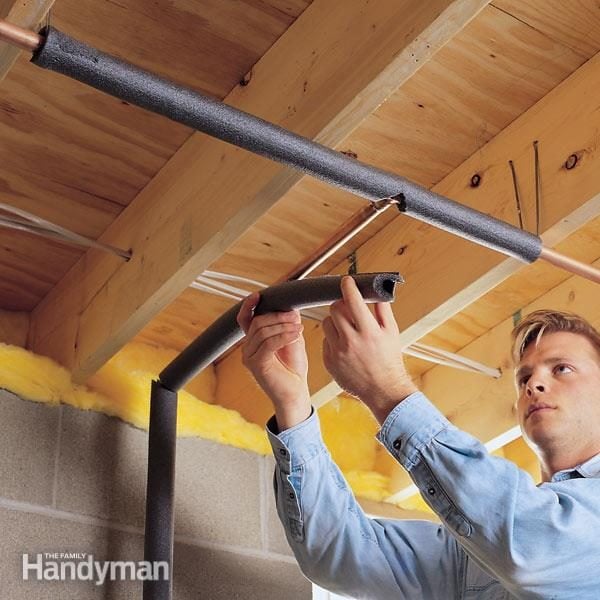Imagine walking into your basement, only to find your feet sinking into a damp, cold floor. Or stepping into your bathroom and feeling a damp chill emanating from the tiles. This is the dreaded “sweating floor” phenomenon, and it can be more than just an annoyance – it can lead to mold growth, structural damage, and even health issues.

Image: www.familyhandyman.com
The good news is, conquering a sweating floor is possible. This comprehensive guide dives into the causes, solutions, and preventative measures to help you reclaim a dry and comfortable home.
Understanding the Causes of Floor Sweating
What is Floor Sweating?
Floor sweating, also known as condensation, occurs when warm, humid air comes into contact with a cold surface. This typically happens in areas with high humidity, such as basements, bathrooms, and even kitchens. The moisture in the air condenses on the cooler floor surface, creating that uncomfortable dampness.
Think of it like a cold glass of water on a hot day. The condensation forming on the outside of the glass is a visual representation of what happens with your floor.
Why Your Floor Might be Sweating
Here are the primary culprits behind floor sweating:
- Inadequate Ventilation: Insufficient airflow allows humidity to build up, creating the conditions for sweating. This is especially common in poorly ventilated basements.
- Moisture Sources: Leaky pipes, water heaters, laundry areas, and even indoor plants can contribute excess moisture to the air.
- Cold Floors: Uninsulated concrete floors are more susceptible to sweating, as they readily absorb and transfer cold from the ground.
- High Humidity Levels: Climates with consistently high humidity make sweating more likely, regardless of ventilation.
- Uneven Temperatures: When the temperatures inside and outside your home fluctuate drastically, condensation is more likely to form on cooler surfaces.

Image: www.themattressguide.co.uk
Practical Solutions to Stop Floor Sweating
1. Improve Ventilation
Ventilation is crucial for removing excess moisture from the air. Here’s how you can enhance it:
- Install Exhaust Fans: Ensure proper exhaust fan operation in bathrooms, kitchens, and laundry rooms to remove steam and humidity.
- Open Windows: Regularly open windows to allow fresh air circulation and reduce humidity, especially in humid environments.
- Consider a Basement Dehumidifier: For chronic sweating, a dehumidifier can effectively remove excess moisture from the air, creating a drier environment.
2. Address Moisture Sources
Identifying and addressing moisture sources is essential for reducing sweating:
- Repair Leaky Pipes and Appliances: Promptly fix any leaks, drips, or faulty appliances that release excess moisture into the air.
- Control Laundry Practices: Properly vent dryer exhaust, avoid overcrowding laundry areas, and minimize steamy showers.
- Maintain Indoor Plants: Water plants responsibly, avoiding overwatering, and consider using trays to catch excess water runoff.
3. Insulate Cold Floors
Insulating cold floors can significantly reduce the temperature difference between the floor and the air, minimizing condensation:
- Insulate Concrete Floors: Use insulation materials like rigid foam boards or spray foam to prevent heat loss and keep the floor warmer.
- Install a Floating Floor: A floating floor system with a vapor barrier can create a warmer floor and prevent moisture transfer.
4. Maintain Consistent Temperatures
Maintaining more consistent temperatures inside and outside your home can help prevent condensation:
- Minimize Temperature Fluctuations: Use a programmable thermostat to keep temperatures relatively consistent, avoiding drastic swings that trigger condensation.
- Consider Sealing Cracks: Seal any cracks in exterior walls, windows, and doors to reduce drafts and maintain a consistent indoor temperature.
5. Moisture-Resistant Flooring
Choosing flooring materials that resist moisture is a proactive step towards preventing sweating:
- Tile: Ceramic and porcelain tiles are excellent choices for moisture-prone areas like bathrooms, basements, and kitchens.
- Vinyl: Vinyl flooring is durable, waterproof, and easy to maintain, making it a popular choice for areas where moisture is an issue.
- Luxury Vinyl Tile (LVT): LVT offers the visual appeal of natural stone or wood but with superior moisture resistance and durability.
Expert Tips to Prevent Floor Sweating
Here are some additional tips for avoiding sweating floors:
- Use Vapor Barriers: Installing a vapor barrier beneath your flooring can stop moisture from rising from the ground and contributing to condensation.
- Consider a Crawl Space Ventilation System: If your basement has a crawl space, proper ventilation can help regulate humidity and prevent moisture buildup.
- Regularly Clean and Maintain Floors: Clean and dry floors regularly to prevent mold growth and minimize moisture buildup.
FAQ about Sweating Floors
Q: How do I know if my floor is sweating?
A: Look for signs like dampness, condensation, water droplets, and a cold, clammy sensation when you touch the floor. You might also notice mold growth or a musty smell.
Q: Is it dangerous for my home if my floor is sweating?
A: Yes, unchecked floor sweating can cause:
- Mold growth: This can trigger allergies and respiratory problems.
- Structural damage: Constant moisture can weaken building materials, leading to structural issues.
- Health issues: Exposure to mold spores can cause allergic reactions, respiratory illnesses, and other health problems.
Q: Can I fix my sweating floor myself?
A: For minor cases, you might be able to address the sweating problem yourself by improving ventilation, addressing moisture sources, and insulating cold floors. However, if the problem is severe or persistent, consulting a professional is recommended for effective solutions.
How Do I Stop My Floor From Sweating
Conclusion
Conquering a sweating floor requires understanding the causes, implementing appropriate solutions, and maintaining a vigilant approach. By following these tips and strategies, you can create a drier, healthier, and more comfortable home environment. Remember, a dry floor is not only aesthetically pleasing but also essential for maintaining the structural integrity and health of your home.
Are you dealing with a sweating floor in your home? Share your experience and any questions you might have in the comments below!





